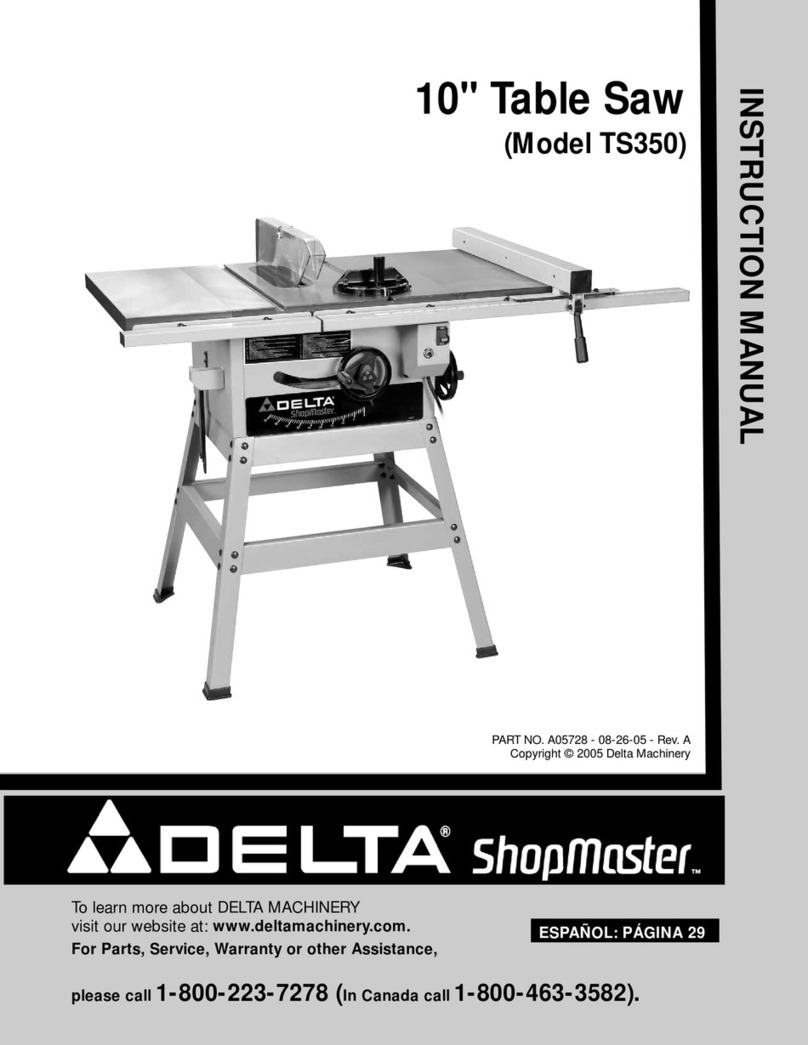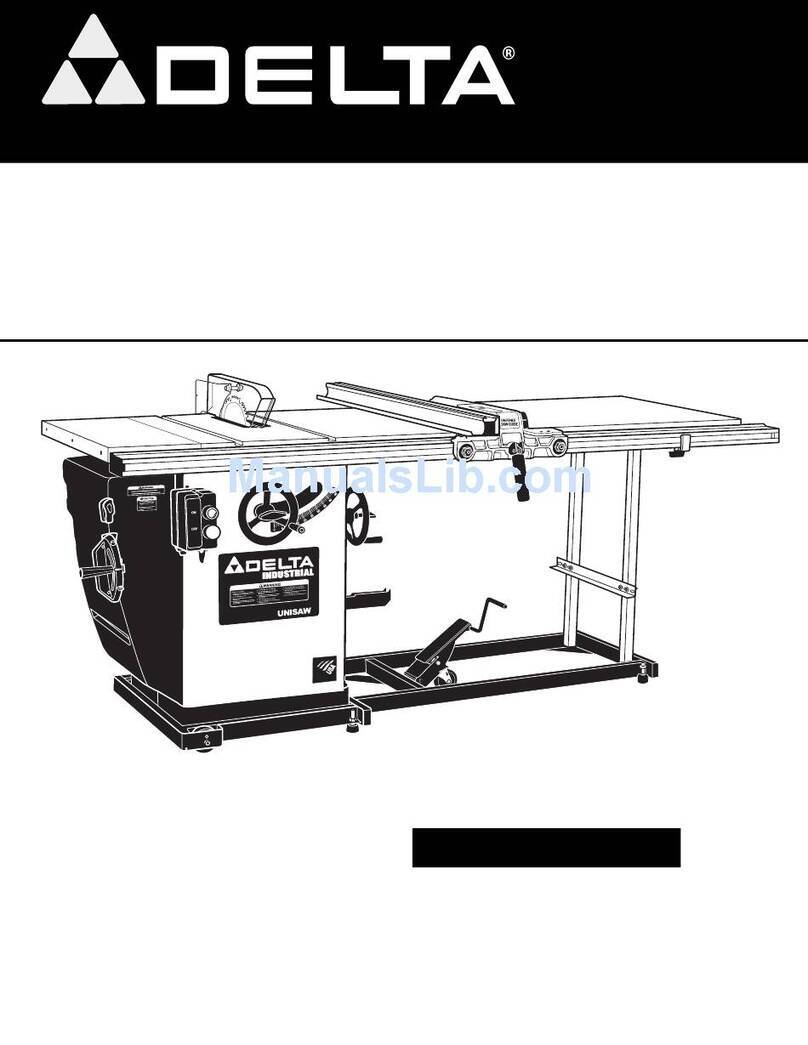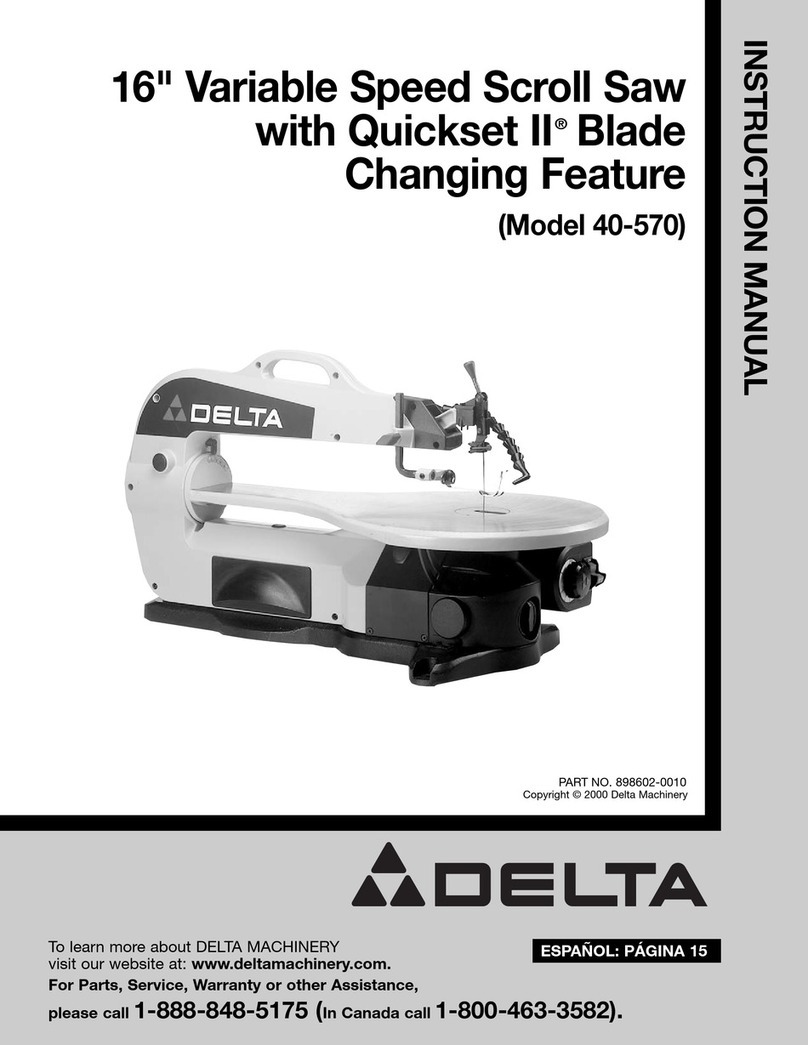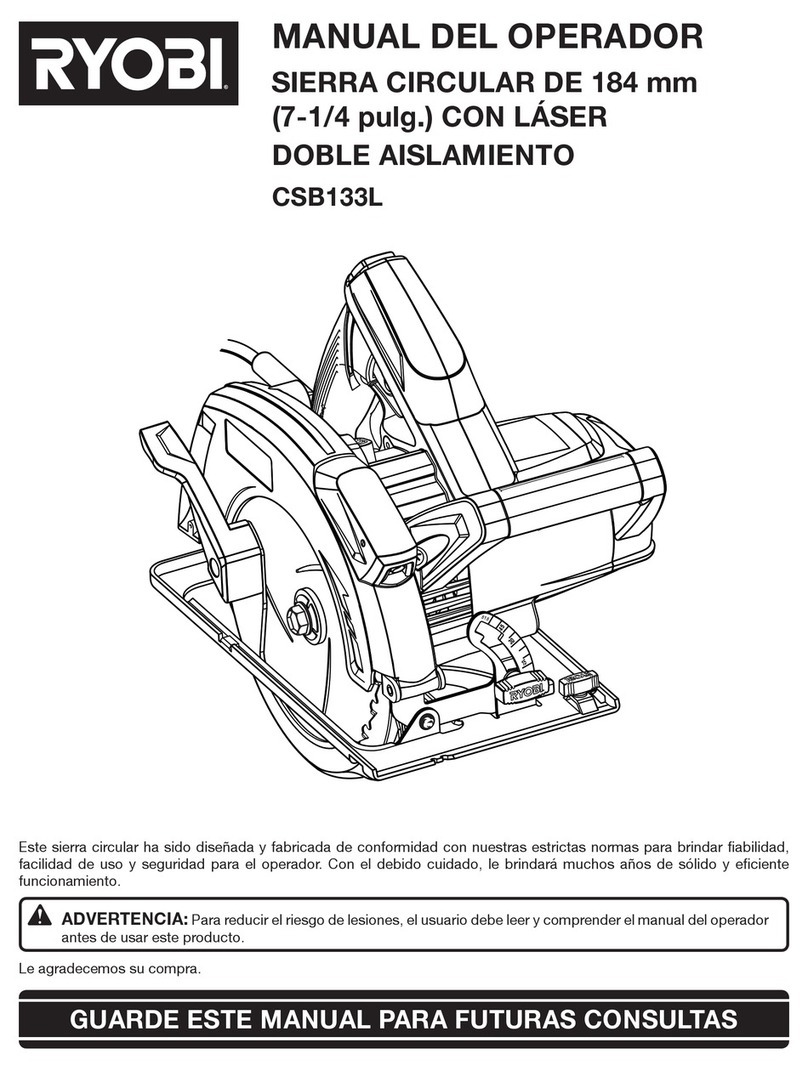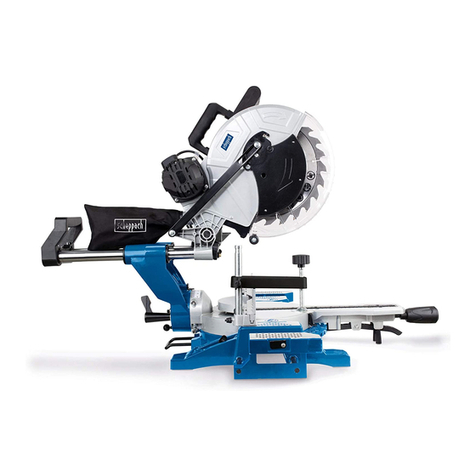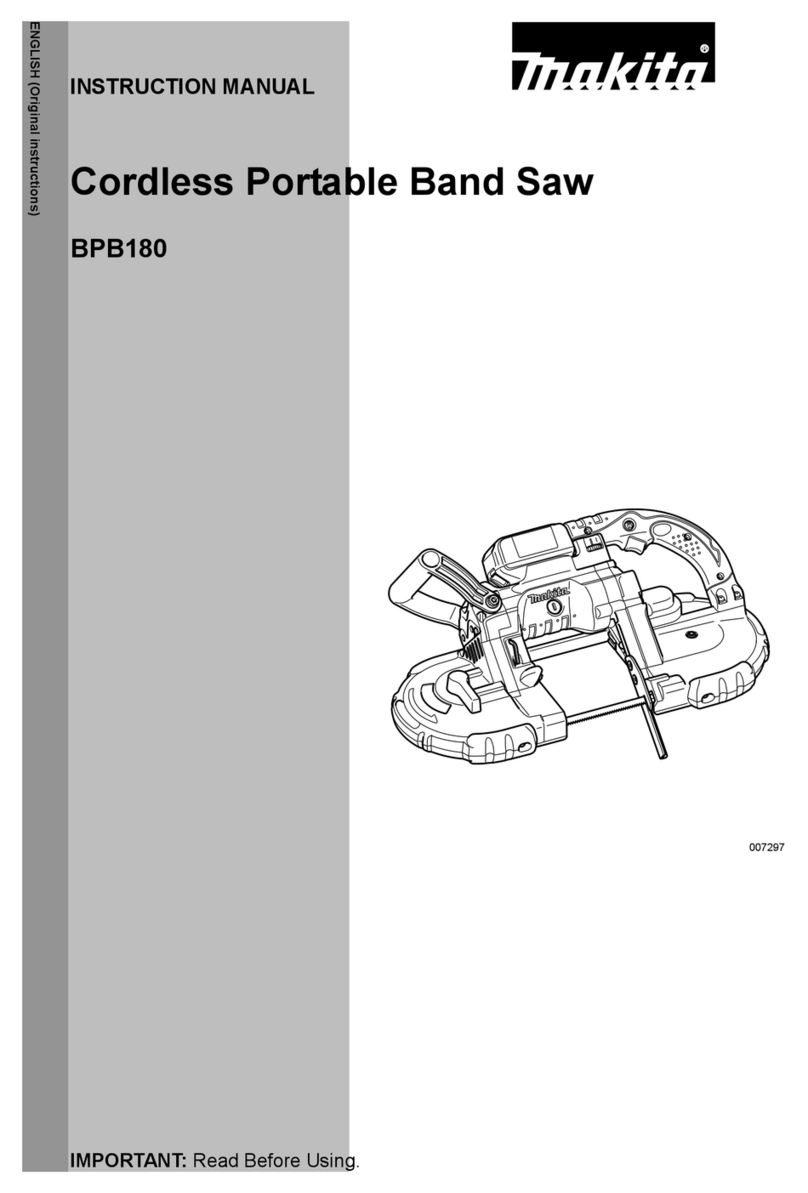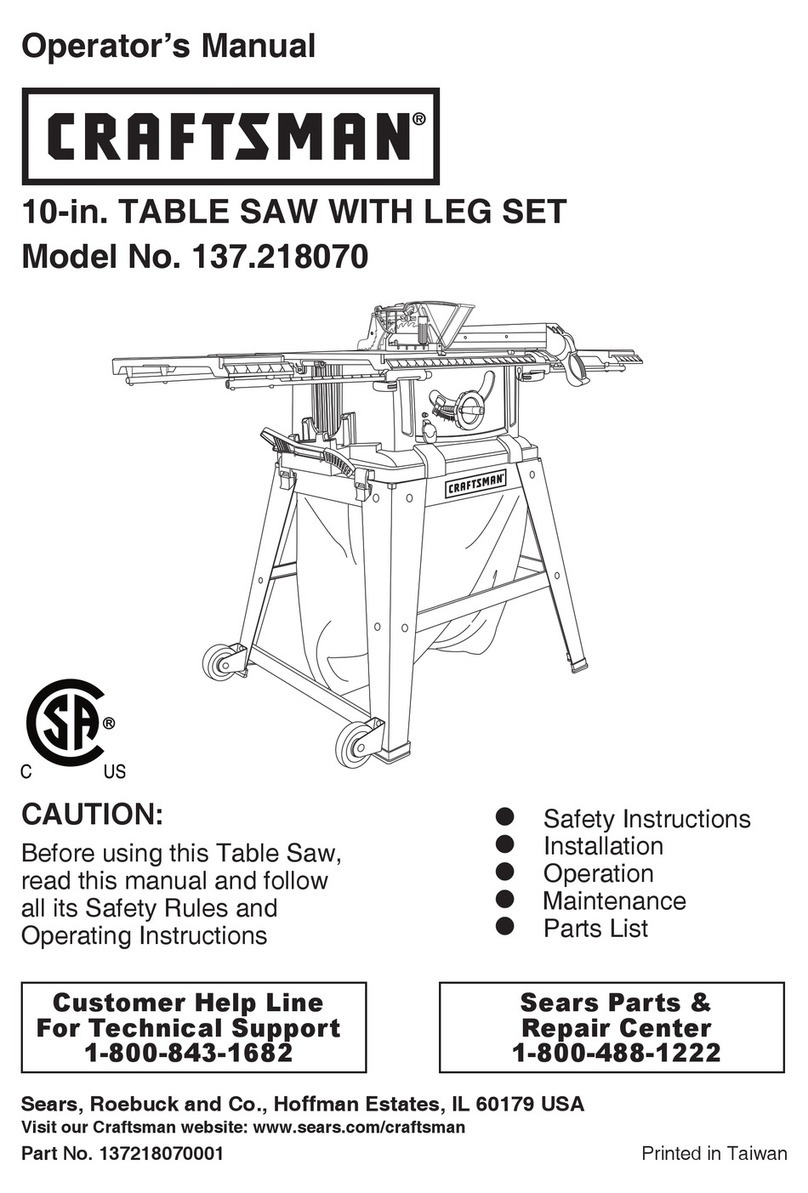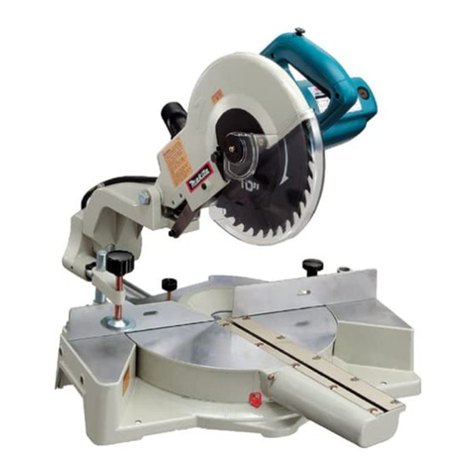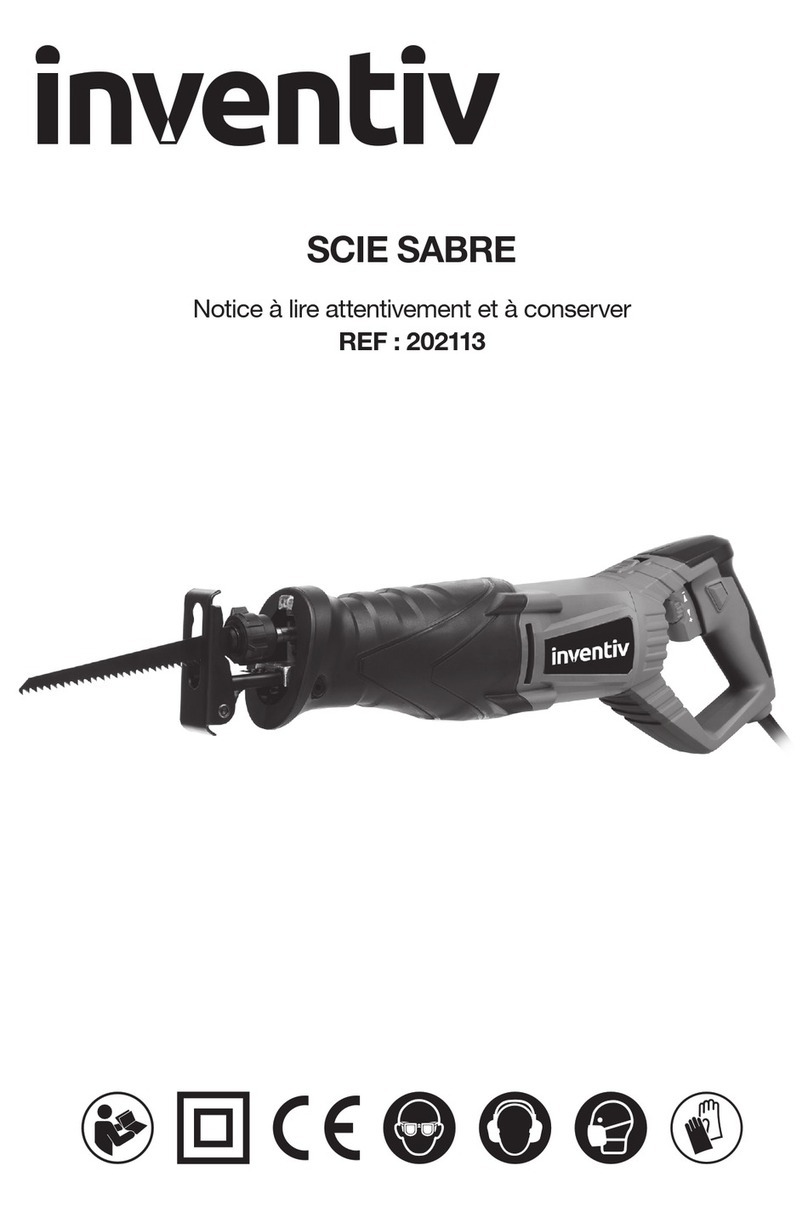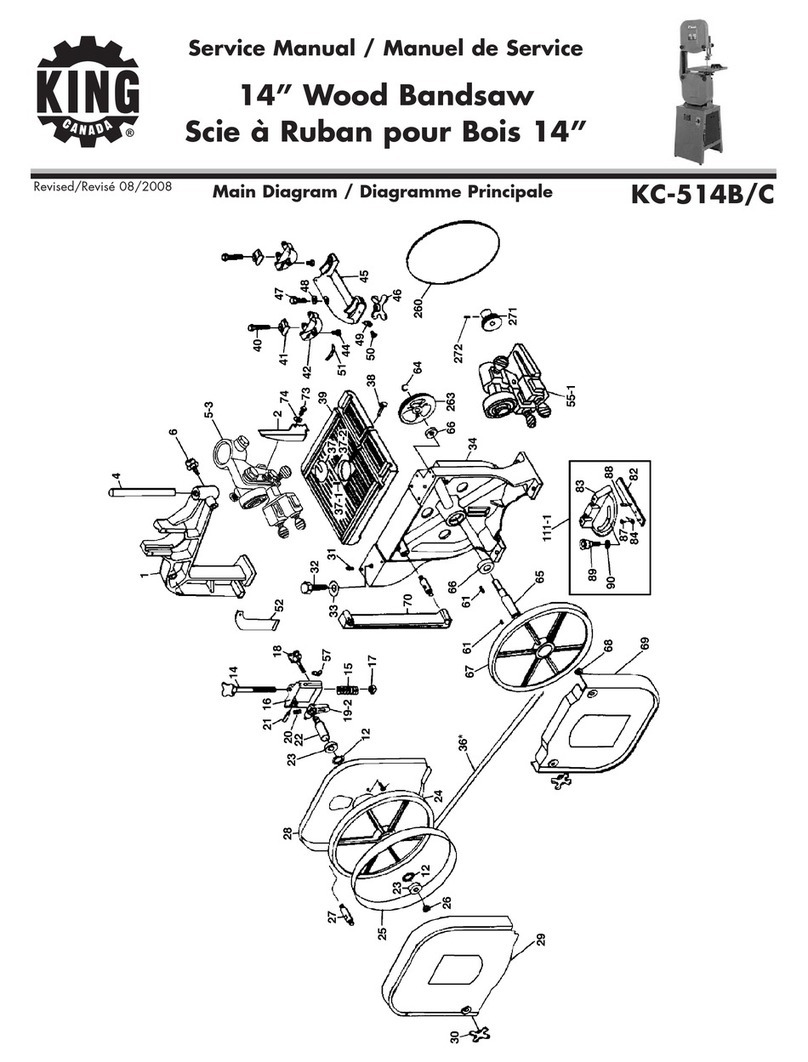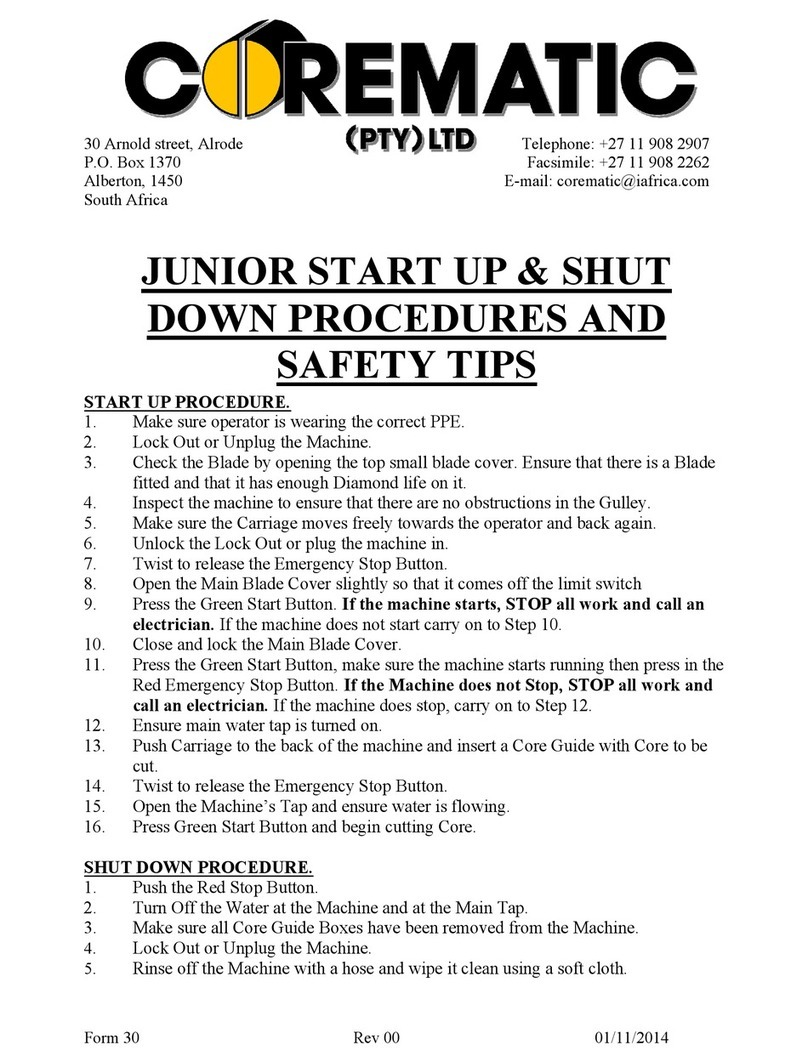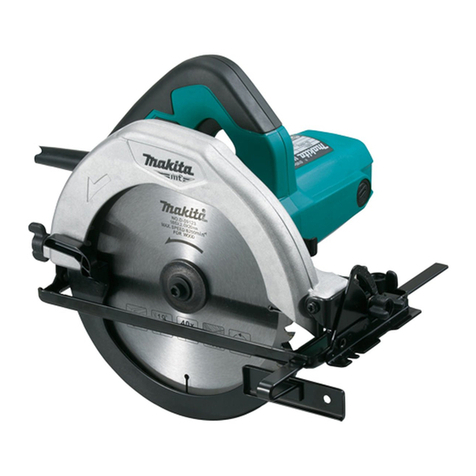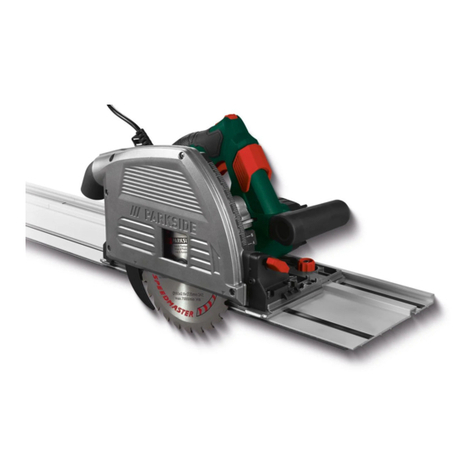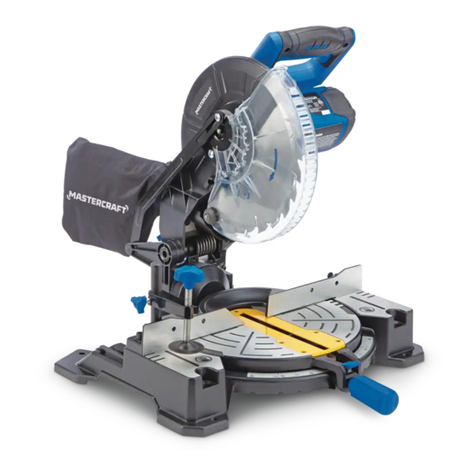Delta ShopMaster MS265 User manual

10" Compound
Power Miter Saw
(Model MS265)
INSTRUCTION MANUAL
ESPAÑOL: PÁGINA 23
To learn more about DELTA MACHINERY
visit our website at: www.deltamachinery.com.
For Parts, Service, Warranty or other Assistance,
please call 1-800-223-7278 (In Canada call 1-800-463-3582).
PART NO. A03556 - 04-26-05
Copyright © 2005 Delta Machinery

2
TABLE OF CONTENTS
Read and understand all warnings and operating instructions before using any tool or equipment. When
using tools or equipment, basic safety precautions should always be followed to reduce the risk of personal injury.
Improper operation, maintenance or modification of tools or equipment could result in serious injury and property
damage. There are certain applications for which tools and equipment are designed. Delta Machinery strongly
recommends that this product NOT be modified and/or used for any application other than for which it was designed.
If you have any questions relative to its application DO NOT use the product until you have written Delta Machinery
and we have advised you.
Online contact form at www.deltamachinery.com
Postal Mail: Technical Service Manager
Delta Machinery
4825 Highway 45 North
Jackson, TN 38305
(IN CANADA: 125 Mural St. Suite 300, Richmond Hill, ON, L4B 1M4)
Information regarding the safe and proper operation of this tool is available from the following sources:
Power Tool Institute
1300 Sumner Avenue, Cleveland, OH 44115-2851
www.powertoolinstitute.org
National Safety Council
1121 Spring Lake Drive, Itasca, IL 60143-3201
American National Standards Institute, 25 West 43rd Street, 4 floor, New York, NY 10036 www.ansi.org
ANSI 01.1Safety Requirements for Woodworking Machines, and
the U.S. Department of Labor regulations www.osha.gov
IMPORTANT SAFETY INSTRUCTIONS
SAVE THESE INSTRUCTIONS!
IMPORTANT SAFETY INSTRUCTIONS . . . . . . . . . . . . . . . . . . . . . . . . . . . . . . . . . . . . . . . . . . . . . . . . . . . . . . . . . . .2
SAFETY GUIDELINES . . . . . . . . . . . . . . . . . . . . . . . . . . . . . . . . . . . . . . . . . . . . . . . . . . . . . . . . . . . . . . . . . . . . . . . .3
GENERAL SAFETY RULES . . . . . . . . . . . . . . . . . . . . . . . . . . . . . . . . . . . . . . . . . . . . . . . . . . . . . . . . . . . . . . . . . . . .4
ADDITIONAL SPECIFIC SAFETY RULES . . . . . . . . . . . . . . . . . . . . . . . . . . . . . . . . . . . . . . . . . . . . . . . . . . . . . . . . .5
FUNCTIONAL DESCRIPTION . . . . . . . . . . . . . . . . . . . . . . . . . . . . . . . . . . . . . . . . . . . . . . . . . . . . . . . . . . . . . . . . . .7
CARTON CONTENTS . . . . . . . . . . . . . . . . . . . . . . . . . . . . . . . . . . . . . . . . . . . . . . . . . . . . . . . . . . . . . . . . . . . . . . . . .8
ASSEMBLY . . . . . . . . . . . . . . . . . . . . . . . . . . . . . . . . . . . . . . . . . . . . . . . . . . . . . . . . . . . . . . . . . . . . . . . . . . . . . . . . .8
OPERATION . . . . . . . . . . . . . . . . . . . . . . . . . . . . . . . . . . . . . . . . . . . . . . . . . . . . . . . . . . . . . . . . . . . . . . . . . . . . . . .10
TROUBLESHOOTING . . . . . . . . . . . . . . . . . . . . . . . . . . . . . . . . . . . . . . . . . . . . . . . . . . . . . . . . . . . . . . . . . . . . . . .19
MAINTENANCE . . . . . . . . . . . . . . . . . . . . . . . . . . . . . . . . . . . . . . . . . . . . . . . . . . . . . . . . . . . . . . . . . . . . . . . . . . . . .19
ACCESSORIES . . . . . . . . . . . . . . . . . . . . . . . . . . . . . . . . . . . . . . . . . . . . . . . . . . . . . . . . . . . . . . . . . . . . . . . . . . . .21
WARRANTY . . . . . . . . . . . . . . . . . . . . . . . . . . . . . . . . . . . . . . . . . . . . . . . . . . . . . . . . . . . . . . . . . . . . . . . . . . . . . . . .22
ESPAÑOL . . . . . . . . . . . . . . . . . . . . . . . . . . . . . . . . . . . . . . . . . . . . . . . . . . . . . . . . . . . . . . . . . . . . . . . . . . . . . . . . . .23
SERVICE CENTER LOCATIONS . . . . . . . . . . . . . . . . . . . . . . . . . . . . . . . . . . . . . . . . . . . . . . . . . . . . . . . .back cover

3
Indicates an imminently hazardous situation which, if not avoided, will result in death or serious injury.
Indicates a potentially hazardous situation which, if not avoided, could result in death or serious injury.
Indicates a potentially hazardous situation which, if not avoided, may result in minor or moderate injury.
Used without the safety alert symbol indicates potentially hazardous situation which, if not avoided, may
result in property damage.
It is important for you to read and understand this manual. The information it contains relates to protecting YOUR
SAFETY and PREVENTING PROBLEMS. The symbols below are used to help you recognize this information.
SAFETY GUIDELINES - DEFINITIONS
SOME DUST CREATED BY POWER SANDING, SAWING, GRINDING, DRILLING, AND OTHER
CONSTRUCTION ACTIVITIES contains chemicals known to cause cancer, birth defects or other reproductive harm.
Some examples of these chemicals are:
· lead from lead-based paints,
· crystalline silica from bricks and cement and other masonry products, and
· arsenic and chromium from chemically-treated lumber.
Your risk from these exposures varies, depending on how often you do this type of work. To reduce your exposure to
these chemicals: work in a well ventilated area, and work with approved safety equipment, always wear NIOSH/OSHA
approved, properly fitting face mask or respirator when using such tools.
CALIFORNIA PROPOSITION 65

4
GENERAL SAFETY RULES
READ AND UNDERSTAND ALL WARNINGS AND OPERATING INSTRUCTIONS BEFORE
USING THIS EQUIPMENT. Failure to follow all instructions listed below, may result in electric shock,
fire, and/or serious personal injury or property damage.
IMPORTANT SAFETY INSTRUCTIONS
1. FOR YOUR OWN SAFETY, READ THE INSTRUCTION
MANUAL BEFORE OPERATING THE MACHINE.
Learning the machine’s application, limitations, and
specific hazards will greatly minimize the possibility of
accidents and injury.
2. WEAR EYE AND HEARING PROTECTION.
ALWAYS USE SAFETY GLASSES. Everyday
eyeglasses are NOT safety glasses. USE CERTIFIED
SAFETY EQUIPMENT. Eye protection equipment
should comply with ANSI Z87.1 standards. Hearing
equipment should comply with ANSI S3.19
standards.
3. WEAR PROPER APPAREL. Do not wear loose
clothing, gloves, neckties, rings, bracelets, or other
jewelry which may get caught in moving parts. Nonslip
footwear is recommended. Wear protective hair
covering to contain long hair.
4. DO NOT USE THE MACHINE IN A DANGEROUS
ENVIRONMENT. The use of power tools in damp or
wet locations or in rain can cause shock or
electrocution. Keep your work area well-lit to prevent
tripping or placing arms, hands, and fingers in danger.
5. MAINTAIN ALL TOOLS AND MACHINES IN PEAK
CONDITION. Keep tools sharp and clean for best and safest
performance. Follow instructions for lubricating and changing
accessories. Poorly maintained tools and machines can further
damage the tool or machine and/or cause injury.
6. CHECK FOR DAMAGED PARTS. Before using the
machine, check for any damaged parts. Check for
alignment of moving parts, binding of moving parts,
breakage of parts, and any other conditions that may
affect its operation. A guard or any other part that is
damaged should be properly repaired or replaced.
Damaged parts can cause further damage to the
machine and/or injury.
7. KEEP THE WORK AREA CLEAN. Cluttered areas and
benches invite accidents.
8. KEEP CHILDREN AND VISITORS AWAY. Your shop is a
potentially dangerous environment. Children and visitors can
be injured.
9. REDUCE THE RISK OF UNINTENTIONAL STARTING.
Make sure that the switch is in the “OFF” position
before plugging in the power cord. In the event of a
power failure, move the switch to the “OFF” position.
An accidental start-up can cause injury.
10. USE THE GUARDS. Check to see that all guards are
in place, secured, and working correctly to reduce
the risk of injury.
11. REMOVE ADJUSTING KEYS AND WRENCHES
BEFORE STARTING THE MACHINE. Tools, scrap
pieces, and other debris can be thrown at high speed,
causing injury.
12. USE THE RIGHT MACHINE. Don’t force a machine or
an attachment to do a job for which it was not
designed. Damage to the machine and/or injury may
result.
13. USE RECOMMENDED ACCESSORIES. The use of
accessories and attachments not recommended by
Delta may cause damage to the machine or injury to the
user.
14. USE THE PROPER EXTENSION CORD. Make sure
your extension cord is in good condition. When using
an extension cord, be sure to use one heavy enough to
carry the current your product will draw. An undersized
cord will cause a drop in line voltage, resulting in loss of
power and overheating. See the Extension Cord Chart
for the correct size depending on the cord length and
nameplate ampere rating. If in doubt, use the next
heavier gauge. The smaller the gauge number, the
heavier the cord.
15. SECURE THE WORKPIECE. Use clamps or a vise to hold
the workpiece when practical. Loss of control of a
workpiece can cause injury.
16. FEED THE WORKPIECE AGAINST THE DIRECTION OF
THE ROTATION OF THE BLADE, CUTTER, OR ABRASIVE
SURFACE. Feeding it from the other direction will cause
the workpiece to be thrown out at high speed.
17. DON’T FORCE THE WORKPIECE ON THE MACHINE.
Damage to the machine and/or injury may result.
18. DON’T OVERREACH. Loss of balance can make you
fall into a working machine, causing injury.
19. NEVER STAND ON THE MACHINE. Injury could occur if the
tool tips, or if you accidentally contact the cutting tool.
20. NEVER LEAVE THE MACHINE RUNNING UNATTENDED.
TURN THE POWER OFF. Don’t leave the machine until it
comes to a complete stop. A child or visitor could be injured.
21. TURN THE MACHINE “OFF”, AND DISCONNECT THE
MACHINE FROM THE POWER SOURCE before installing
or removing accessories, before adjusting or changing
set-ups, or when making repairs. An accidental start-up
can cause injury.
22. MAKE YOUR WORKSHOP CHILDPROOF WITH
PADLOCKS, MASTER SWITCHES, OR BY
REMOVING STARTER KEYS. The accidental start-up
of a machine by a child or visitor could cause injury.
23. STAY ALERT, WATCH WHAT YOU ARE DOING, AND
USE COMMON SENSE. DO NOT USE THE
MACHINE WHEN YOU ARE TIRED OR UNDER THE
INFLUENCE OF DRUGS, ALCOHOL, OR MEDICAT-
ION. A moment of inattention while operating power
tools may result in injury.
24. USE OF THIS TOOL CAN GENERATE
AND DISBURSE DUST OR OTHER AIRBORNE
PARTICLES, INCLUDING WOOD DUST,
CRYSTALLINE SILICA DUST AND ASBESTOS DUST.
Direct particles away from face and body. Always
operate tool in well ventilated area and provide for
proper dust removal. Use dust collection system
wherever possible. Exposure to the dust may cause
serious and permanent respiratory or other injury,
including silicosis (a serious lung disease), cancer, and
death. Avoid breathing the dust, and avoid prolonged
contact with dust. Allowing dust to get into your mouth
or eyes, or lay on your skin may promote absorption of
harmful material. Always use properly fitting
NIOSH/OSHA approved respiratory protection
appropriate for the dust exposure, and wash exposed
areas with soap and water.

5
FAILURE TO FOLLOW THESE RULES MAY RESULT IN SERIOUS PERSONAL INJURY.
1. DO NOT OPERATE THIS MACHINE UNTIL it is
assembled and installed according to the
instructions.
2. OBTAIN ADVICE from your supervisor, instructor,
or another qualified person if you are not familiar
with the operation of this machine.
3. FOLLOW ALL WIRING CODES and recommended
electrical connections.
4 MOUNT THE TOOL SECURELY to a stable
supporting surface prior to operation
5. DO NOT OPERATE SAW WITHOUT GUARDS IN
PLACE. Check to see that they are in place,
secured, and working correctly.
6. USE ONLY CROSSCUT SAW BLADES. Use only
zero-degree or negative hook angles when using
carbide-tipped blades. Do not use blades with deep
gullets. These can deflect and contact the guard.
7. USE ONLY BLADES OF THE CORRECT SIZE AND
TYPE specified for this tool.
8. USE A SHARP BLADE. Check blade to see if it runs
freely and is free from vibration.
9. INSPECT BLADE FOR CRACKS or other damage
prior to operation. Replace cracked or damaged
blade immediately.
10. CLEAN THE BLADE AND BLADE FLANGES prior
to operation. Check for any damage and tighten the
arbor nut securely.
11. USE ONLY BLADE FLANGES specified for this tool.
12. CLEAR THE AREA OF FLAMMABLE LIQUIDS
and/or gas prior to operation.
13. CLEAN THE MOTOR AIR SLOTS of chips and
sawdust.
14. TIGHTEN THE TABLE CLAMP HANDLE and any
other clamps prior to operation.
15. NEVER START THE TOOL with the workpiece
against the blade.
16. KEEP HANDS out of path of saw blade. Clamp all
workpieces that would require your hand to be in the
“Table Hazard Zone” (within the red lines).
17. ALLOW THE MOTOR to come to full speed prior to
starting cut.
18. NEVER REACH AROUND or behind the saw blade.
19. NEVER CUT FERROUS METALS or masonry.
ADDITIONAL SPECIFIC SAFETY RULES
20. NEVER RECUT SMALL PIECES.
21. NEVER LOCK THE SWITCH in the “ON” position.
22. NEVER APPLY LUBRICANT to a running blade.
23. DO NOT PERFORM FREE-HAND OPERATIONS.
Hold the work firmly against the fence and table.
Use clamps to hold the work when possible.
24. PROPERLY SUPPORT LONG or wide workpieces.
25. AFTER COMPLETING CUT, release power switch
and wait for coasting blade to come to a complete
stop before returning saw to raised position. Make
sure saw cuttinghead returns freely to the full raised
position to ensure the lower blade guard fully
encloses the blade.
26. TURN OFF TOOL AND ALLOW THE BLADE TO
COME TO A COMPLETE STOP prior to cleaning
the blade area or removing debris in the path of the
blade. A coasting blade can be dangerous.
27. TURN OFF TOOL AND ALLOW BLADE TO COME
TO A COMPLETE STOP before removing or
securing workpiece, changing workpiece angle, or
changing the angle of the blade.
28. NEVER PERFORM LAYOUT, ASSEMBLY, or set-
up work on the table/work area when the machine is
running.
29. TURN THE MACHINE “OFF” AND DISCONNECT
THE MACHINE from the power source before
installing or removing accessories, before adjusting
or changing set-ups, or when making repairs.
30. TURN THE MACHINE “OFF”, disconnect the
machine from the power source, and clean the
table/work area before leaving the machine. LOCK
THE SWITCH IN THE “OFF” POSITION to prevent
unauthorized use.
31. ADDITIONAL INFORMATION regarding the safe
and proper operation of this tool, including a miter
saw safety video, is available from the Power Tool
Institute, 1300 Summer Avenue, Cleveland, OH
44115-2851. Information is also available from the
National Safety Council, 1121 Spring Lake Drive,
Itasca, IL 60143-3201. Please refer to the American
National Standards Institute ANSI 01.1 Safety
Requirements for Woodworking Machines and the
U.S. Department of Labor OSHA 1910.213
Regulations.
SAVE THESE INSTRUCTIONS.
Refer to them often and use them to instruct others

6
A separate electrical circuit should be used for your machines. This circuit should not be less than #12 wire and should
be protected with a 20 Amp time lag fuse. If an extension cord is used, use only 3-wire extension cords which have 3-
prong grounding type plugs and matching receptacle which will accept the machine’s plug. Before connecting the
machine to the power line, make sure the switch (s) is in the “OFF” position and be sure that the electric current is of
the same characteristics as indicated on the machine. All line connections should make good contact. Running on low
voltage will damage the machine.
DO NOT EXPOSE THE MACHINE TO RAIN OR OPERATE THE MACHINE IN DAMP LOCATIONS.
Fig. A Fig. B
GROUNDED OUTLET BOX
CURRENT
CARRYING
PRONGS
GROUNDING BLADE
IS LONGEST OF THE 3 BLADES
GROUNDED OUTLET BOX
GROUNDING
MEANS
ADAPTER
2. Grounded, cord-connected machines intended for
use on a supply circuit having a nominal rating less than
150 volts:
If the machine is intended for use on a circuit that has an
outlet that looks like the one illustrated in Fig. A,the machine
will have a grounding plug that looks like the plug illustrated
in Fig. A. A temporary adapter, which looks like the adapter
illustrated in Fig. B, may be used to connect this plug to a
matching 2-conductor receptacle as shown in Fig. B if a
properly grounded outlet is not available. The temporary
adapter should be used only until a properly grounded outlet
can be installed by a qualified electrician. The green-colored
rigid ear, lug, and the like, extending from the adapter must
be connected to a permanent ground such as a properly
grounded outlet box. Whenever the adapter is used, it must
be held in place with a metal screw.
NOTE: In Canada, the use of a temporary adapter is not
permitted by the Canadian Electric Code.
IN ALL CASES, MAKE CERTAIN THE
RECEPTACLE IN QUESTION IS
PROPERLY GROUNDED. IF YOU ARE NOT SURE HAVE A
QUALIFIED ELECTRICIAN CHECK THE RECEPTACLE.
1. All grounded, cord-connected machines:
In the event of a malfunction or breakdown, grounding
provides a path of least resistance for electric current to
reduce the risk of electric shock. This machine is equipped
with an electric cord having an equipment-grounding
conductor and a grounding plug. The plug must be plugged
into a matching outlet that is properly installed and grounded
in accordance with all local codes and ordinances.
Do not modify the plug provided - if it will not fit the outlet,
have the proper outlet installed by a qualified electrician.
Improper connection of the equipment-grounding
conductor can result in risk of electric shock. The
conductor with insulation having an outer surface that is
green with or without yellow stripes is the equipment-
grounding conductor. If repair or replacement of the electric
cord or plug is necessary, do not connect the equipment-
grounding conductor to a live terminal.
Check with a qualified electrician or service personnel if the
grounding instructions are not completely understood, or if
in doubt as to whether the machine is properly grounded.
Use only 3-wire extension cords that have 3-prong grounding
type plugs and matching 3-conductor receptacles that
accept the machine’s plug, as shown in Fig. A.
Repair or replace damaged or worn cord immediately.
POWER CONNECTIONS
MOTOR SPECIFICATIONS
Your machine is wired for 120 volts, 60 HZ alternating current. Before connecting the machine to the power source,
make sure the switch is in the “OFF” position.
GROUNDING INSTRUCTIONS
THIS MACHINE MUST BE GROUNDED WHILE IN USE TO PROTECT THE OPERATOR FROM
ELECTRIC SHOCK.

7
FOREWORD
Delta ShopMaster Model MS265 is a 10" Compound Power Miter Saw designed to cut wood, plastic, and aluminum.
Compound angle and bevel cutting are easy and accurate. It can crosscut up to 5-5/8" x 2-3/4", miter at 45° both left
and right 4" x 2-3/4", bevel at 45° left 5-5/8" x 1-5/8", and compound 45° x 45°, 4" x 1-5/8". It has positive miter at 0°,
15°, 22.5°, 31.62°, and 45° both left and right, and bevel stops at 0° and 45° degrees adjustable.
FUNCTIONAL DESCRIPTION
EXTENSION CORDS
Use proper extension cords. Make sure
your extension cord is in good condition and is a 3-wire
extension cord which has a 3-prong grounding type
plug and matching receptacle which will accept the
machine’s plug. When using an extension cord, be sure
to use one heavy enough to carry the current of the
machine. An undersized cord will cause a drop in line
voltage, resulting in loss of power and overheating. The
chart at right shows the correct gauge to use
depending on the cord length. If in doubt, use the next
heavier gauge. The smaller the gauge number, the
heavier the cord.
MINIMUM GAUGE EXTENSION CORD
RECOMMENDED SIZES FOR USE WITH STATIONARY ELECTRIC MACHINES
Ampere Total Length Gauge of
Rating Volts of Cord in Feet Extension Cord
0-6 120
up to
25 18 AWG
0-6 120 25-50 16 AWG
0-6 120 50-100 16 AWG
0-6 120 100-150 14 AWG
6-10 120
up to
25 18 AWG
6-10 120 25-50 16 AWG
6-10 120 50-100 14 AWG
6-10 120 100-150 12 AWG
10-12 120
up to
25 16 AWG
10-12 120 25-50 16 AWG
10-12 120 50-100 14 AWG
10-12 120 100-150 12 AWG
12-16 120
up to
25 14 AWG
12-16 120 25-50 12 AWG
12-16 120 GREATER THAN 50 FEET NOT RECOMMENDED
NOTICE: THE PHOTO ON THE MANUAL COVER ILLUSTRATES THE
CURRENT PRODUCTION MODEL. ALL OTHER ILLUSTRATIONS CONTAINED
IN THE MANUAL ARE REPRESENTATIVE ONLY AND MAY NOT DEPICT THE
ACTUAL COLOR, LABELING OR ACCESSORIES AND ARE INTENDED TO
ILLUSTRATE TECHNIQUE ONLY.
UNPACKING AND CLEANING
Carefully unpack the machine and all loose items from the shipping container(s). Remove the protective coating from
all unpainted surfaces. This coating may be removed with a soft cloth moistened with kerosene (do not use acetone,
gasoline or lacquer thinner for this purpose). After cleaning, cover the unpainted surfaces with a good quality household
floor paste wax.

1. Place the bevel lock handle screw (A) Fig. 3 onto the
bevel hub (B) on the base of the miter saw arm.
2. Thread the bevel lock handle screw (A) Fig. 3 onto the
bevel hub (B) by turning the bevel handle knob (C).
Tighten securely.
8
ASSEMBLY
FOR YOUR OWN SAFETY, DO NOT CONNECT THE MACHINE TO THE POWER SOURCE UNTIL THE
MACHINE IS COMPLETELY ASSEMBLED, AND YOU READ AND UNDERSTAND THE ENTIRE INSTRUCTION
MANUAL.
ATTACHING MITER SAW ARM TO BASE
Fig. 3
B
A
C
ASSEMBLY TOOLS REQUIRED
ASSEMBLY TIME ESTIMATE
3mm hex wrench (supplied)
1/2" Blade Wrench (supplied)
Assembly time for this product will be about 30 minutes to an hour.
CARTON CONTENTS
1. Miter Saw Arm
2. Miter Saw Base
3. Table Lock Handle
4. Clamp
12
3
4
5
5. Dust Bag
6. 5mm Hex Wrench
7. 1/2" Blade Wrench
LIFTING THE MITER SAW BY THE SWITCH HANDLE CAN CAUSE MISALIGNMENT. ALWAYS LIFT
THE MACHINE BY THE BASE OR THE CARRYING HANDLE (SEE FIG. 20).
6
7
Remove the miter saw and all loose items from the carton.
DISCONNECT MACHINE FROM POWER SOURCE.

9
Thread the table lock handle (A) Fig. 5 into the threaded hole of the arm bracket (C).
ROTATING TABLE
Loosen the table-lock handle one or two turns. Raise
the index lever (B) Fig. 5 and rotate the table to the
desired position. Tighten the table-lock handle.
MOVING CUTTINGHEAD TO THE UP POSITION
ATTACHING DUST BAG
Attach the dust bag (A) Fig. 7 to the dust spout (B) making sure the wire ring (C) is engaged with the ridge in the spout
(see inset).
B
A
Fig. 5
A
Fig. 6 Fig. 7
A
C
B
FASTENING MACHINE TO SUPPORTING SURFACE
Before operating your compound miter saw, mount it to
a sturdy workbench or other supporting surface. Four
holes are provided, two of which are shown at (A) Fig. 8.
When frequently moving the saw from place to place,
mount the saw to a 3/4″piece of plywood. The tool can
then be easily moved from place to place and the
plywood can be clamped to a supporting surface using
“C” clamps.
A
Fig. 8
1. Push down on cuttinghead and pull out cuttinghead lock knob (A) Fig. 6.
2. Move the cuttinghead to the up position.
ATTACHING TABLE LOCK HANDLE
C

A TURNING SAW BLADE CAN BE DANGEROUS. AFTER COMPLETING THE CUT, RELEASE THE
SWITCH TRIGGER (A) FIG. 9 TO ACTIVATE THE BLADE BRAKE. KEEP THE CUTTINGHEAD DOWN
UNTIL THE BLADE HAS COME TO A COMPLETE STOP.
10
STARTING AND STOPPING THE
MITER SAW
THE TORQUE DEVELOPED DURING BRAKING MAY LOOSEN THE ARBOR SCREW. CHECK THE
ARBOR SCREW PERIODICALLY AND TIGHTEN, IF NECESSARY.
LOCKING THE SWITCH IN THE
“OFF” POSITION
WHEN THE MACHINE IS NOT IN USE,
THE SWITCH SHOULD BE LOCKED IN
THE “OFF” POSITION, USING A
PADLOCK (B) FIG. 10 WITH A 3/16"
DIAMETER SHACKLE TO PREVENT
UNAUTHORIZED USE.
To start the miter saw, depress the switch trigger (A) Fig.
9. To stop the miter saw, release the switch trigger.
This saw is equipped with an automatic electric blade
brake. As soon as the switch trigger (A) Fig. 9 is
released, the electric brake is activated and stops the
blade in seconds.
A
Fig. 9
B
Fig. 10
OPERATION
TABLE HAZARD AREA
THE AREA INSIDE THE TWO RED
LINES ON THE TABLE (A) FIG. 11 IS
DESIGNATED AS A "HAZARD ZONE".
NEVER PLACE YOUR HANDS INSIDE
THIS AREA WHILE THE MACHINE IS
RUNNING.
Keep your hands out of the path of the
saw blade. If necessary, clamp the
workpiece in place before making the
cut.
A
Fig. 11
WORK CLAMP
Fig. 12
A
B
Some Delta miter saws come with a work clamp. If your
machine has a work clamp, you can position it in one of
two holes (B) Fig 12 in the left or right side of the base.
Use this clamp, especially with short workpieces.
OPERATING CONTROLS AND ADJUSTMENTS

11
Your miter saw will cut any angle from a straight 90° cut to 47° right and left. Loosen the lock handle (A) Fig. 13 one or two
turns, depress the index lever (B), and move the control arm to the desired angle. TIGHTEN THE LOCK HANDLE (A).
The miter saw is equipped with positive stops at the 0°, 15.5°, 22.5°, 31.62° and 45° right and left positions. Loosen the
lock handle (A) Fig. 13, and move the control arm until the bottom of the index lever (B) engages into one of the positive
stops (C) Fig. 14. TIGHTEN THE LOCK HANDLE (A) Fig. 13. To disengage the positive stop, depress the index lever (B).
In addition, an indicator (D) Fig. 13 is provided on the miter scale at the 31.62° right and left miter positions for cutting
crown moulding. (Refer to the “CUTTING CROWN MOULDING” section of this manual).
IMPORTANT: Always tighten the lock handle (A) Fig. 13 before cutting.
POINTER AND SCALE
A pointer (A) Fig. 15 is supplied to indicate the actual angle of cut. Each line on the scale (B) represents 1 degree. When
the pointer is moved from one line to the next on the scale, the angle of cut is changed by 1 degree.
B
A
C
Fig. 13 Fig. 14
D
A
B
Fig. 15
When transporting the saw, lock the cuttinghead in the down position. Lower the cutting arm and push in the plunger (A)
Fig. 16 until the other end of the plunger (A) engages with the hole in the cutting arm (B).
IMPORTANT: LiFTING THE MACHINE BY THE SWITCH HANDLE WILL CAUSE MISALIGNMENT. ALWAYS LIFT THE
MACHINE BY THE BASE OR BY THE CARRYING HANDLE (SEE FIG. 20).
LOCKING CUTTINGHEAD IN THE DOWN POSITION
A
B
Fig. 16
ROTATING THE TABLE FOR MITER CUTTING

12
SIDE SUPPORTS
This machine has two side supports to help stabilize the machine, and to help support long or wide workpieces.
The supports are located on either side of the table. The machine comes with the supports in the saw (Fig. 20A). To
utilize the supports, pull them out to their full length (Fig. 20B).
Fig. 20A Fig. 20B
A rear support bar (A) Fig. 18 is provided to prevent the machine from tipping to the rear when the cuttinghead is
returned to the “up” position. For maximum support, the bar (A) Fig. 19 should be pulled out as far as possible. The
stabilizer bar (A) Fig. 20 can also be used to carry the machine.
REAR STABILIZER/CARRYING HANDLE
Fig. 18 Fig. 19 Fig. 20
AA
A
Fully extend the stabilizer bar before operating the saw.
The cuttinghead of your compound miter saw can be
tilted to cut any bevel angle from a 90° straight cut off to
a 45° left bevel angle. Loosen bevel lock handle (A) Fig.
17, tilt the cutting arm to the desired angle, and tighten
the lock handle (A).
Positive stops are provided to rapidly position the saw
blade at 90° and 45° to the table. Refer to the section of
this manual titled “ADJUSTING 90° AND 45° DEGREE
BEVEL STOPS.” The bevel angle of the cutting arm is
determined by the position of the pointer (B) Fig. 17 on
the scale (C).
In addition, a triangle indicator is provided on the bevel
scale at 33.86° for cutting crown moulding. Refer to the “CUTTING CROWN MOULDING” section of this manual.
TILTING CUTTINGHEAD FOR BEVEL CUTTING
A
B
C
Fig. 17

13
If the fence (A) Fig. 22 is removed from the saw, adjust it after replacement so that it is 90 degrees to the blade.
DISCONNECT MACHINE FROM POWER SOURCE.
1. Place one end of the square (B) Fig. 22 against the fence (A) and the other end against the blade (C).
2. To adjust, loosen the four screws (D) Fig. 23 and adjust fence 90° to the blade. Tighten the screws (D).
DISCONNECT MACHINE FROM POWER
SOURCE.
1. The downward travel of the saw blade should be
limited to prevent the saw blade from contacting any
metal surfaces of the machine. This adjustment is
made by loosening the locknut (A) Fig. 24, and
turning the adjusting screw (B) in or out.
2. Lower the blade as far as possible. Rotate the blade
by hand to ensure that the teeth do not contact any
metal surfaces. Adjust if necessary.
3. After the downward travel of the saw blade has been
adjusted, tighten the locknut (A)
ADJUSTING FENCE 90°TO BLADE
A
B
C
DD
ADJUSTING DOWNWARD TRAVEL OF SAW BLADE
Fig. 22 Fig. 23
Fig. 24
A
B
DISCONNECT MACHINE FROM POWER
SOURCE.
1. Lower the cutting arm. The saw blade (A) Fig. 21
should be parallel to the left edge (B) of the table
opening.
2. If an adjustment is necessary, loosen two screws (C)
Inset, and move the cutting arm until the blade is
parallel with the left edge (B) of the table opening
and centered in the slot. Then tighten the two
screws (C).
A
B
C
Fig. 21
ADJUSTING BLADE PARALLEL TO TABLE SLOT

14
Fig. 29Fig. 28
A
B
CA
B
DISCONNECT MACHINE FROM POWER SOURCE.
1. Loosen the bevel lock handle and move the cutting arm all the way to the right. Tighten the bevel lock handle.
2. Place one end of a square (A) Fig. 25 on the table and the other end against the blade. Check to see if the blade
is 90° to the table (Fig. 25).
3. If an adjustment is necessary, loosen the locknut (A) Fig. 26. Turn the screw (B) until the head of the screw contacts
the casting (C) when the blade is 90° to the table. Tighten the locknut (B).
ADJUSTING 90°AND 45°BEVEL STOPS
4. Loosen the bevel lock handle and move the cutting
arm all the way to the left bevel position. Tighten the
bevel lock handle.
5. Use a combination square (A) Fig. 27 to see if the
blade is at 45° to the table.
6. If an adjustment is necessary, loosen the locknut (A)
Fig. 28. Turn the screw (B) until the screw (B) contacts
the casting (C) when the blade is 45 degrees to the
table. Tighten the locknut (E).
7. Check to see that the bevel pointer (A) Fig. 29 is
pointing to the 45° mark on the bevel scale. To
adjust the bevel pointer (A), loosen the screw (B) and
adjust the pointer (A). Tighten the screw (B) securely.
A
Fig. 25 Fig. 26
CB
A
Fig. 27
A

15
TYPICAL OPERATIONS AND HELPFUL HINTS
IF THE WORKPIECE CAUSES YOUR
HAND TO BE IN THE HAZARD ZONE
OF OF THE SAW BLADE, CLAMP THE
WORKPIECE IN PLACE BEFORE
MAKING THE CUT.
1. Before cutting, make certain that the cutting arm
and table are at the correct settings and firmly
locked in place.
2. Place the workpiece on the table and hold or clamp
it firmly against the fence (Fig. 31).
3. For best results, cut at a slow, even cutting rate.
4. Never attempt freehand cutting (wood that is not
held firmly against the fence and table).
AUXILIARY WOOD FENCE
Multiple or repetitive cut-off operations that result in
small cut-off pieces (one inch or less) can cause the saw
blade to catch the cut-off pieces and project them out
of the machine or into the blade guard and housing,
possibly causing damage or injury.
TO LIMIT THE POSSIBILITY OF
PERSONAL INJURY OR BLADE
GUARD DAMAGE, MOUNT AN
AUXILIARY WOOD FENCE ON YOUR
SAW.
Holes are provided in the fence to attach an auxiliary fence (A) Fig. 32. This auxiliary fence is constructed of straight
wood approximately 1/2" thick by 3" high by 20" long.
NOTE: The auxiliary fence (A) is used ONLY with the saw blade in the 0° bevel position (90° to the table). When bevel
cutting (blade tilted), remove the auxiliary fence.
Fig. 31
Fig. 32
A
AA
The tension of the cuttinghead return spring was adjusted
at the factory so that the cuttinghead returns to the “up”
position after a cut has been made. If it becomes neces-
sary to adjust the spring tension:
DISCONNECT MACHINE FROM POWER
SOURCE.
Loosen the locknut (A) Fig. 30 and turn the screw (B)
clockwise to increase, or counterclockwise to decrease
the spring tension. After adjustment, tighten the locknut
(A).
ADJUSTING TENSION OF CUTTINGHEAD RETURN SPRING
A
B
Fig. 30
MACHINE USE

16
GENERAL CUTTING OPERATIONS
1. Your machine has the capacity to cut standard 2 x 4’s lying flat or on edge, at the 45 degree right and left miter angles (Figs.
A1 and A2).
2. A standard 2 x 6 can be cut in the 90 degree straight cut-off position in one pass (Fig. A3).
3. Cutting a standard 4 x 4 can be accomplished with one pass (Fig. A4).
4. This machine has the capacity to accurately cut crown mouldings and other bevel-type cuts (Fig. A5).
5. Cutting various sizes of plastic pipe is an easy job with this machine (Fig. A6).
Fig. A1 Fig. A2
Fig. A3 Fig. A4
Fig. A5 Fig. A6

17
CUTTING BOWED MATERIAL
When cutting flat pieces, first check to see if the material is bowed. If it is, make sure the material is positioned on the
table as shown in Fig. 35.
If the material is positioned the wrong way (Fig. 36), the workpiece will pinch the blade near the completion of the cut.
RIGHT WRONG
Fig. 35 Fig. 36
CUTTING ALUMINUM
Aluminum extrusions used for making aluminum screens and storm windows can easily be cut with your compound
miter saw. When cutting aluminum extrusions, or other sections that can be cut with a saw blade and are within the
capacity of the machine, position the material so the blade is cutting through the smallest cross-section (Fig. 33). The
wrong way to cut aluminum angles is illustrated in Fig. 34. Be sure to apply a stick wax to the blade before cutting
aluminum stock. This stick wax is available at most industrial mill supply houses. The wax provides proper lubrication
and keeps chips from adhering to the blade.
Never apply lubricant to the blade while the machine is running.
FENCE BLADE
WRONG
FENCE BLADE
RIGHT
Fig. 33 Fig. 34
WORK SUPPORT EXTENSIONS
For support when cutting long pieces, construct a work
support extension. Fig. 39 illustrates the miter saw
mounted on two standard 2 x 4’s (A). Fasten the four
mounting legs (two of which are shown at (B) Fig. 39 to
the 2 x 4’s, using four screws (not supplied) through the
four holes in the mounting legs. The length of the 2 x 4’s
(A) can vary, depending on the workpiece.
NOTE: Ensure that the top of the support 2 x 4’s (C)
are level with the miter saw table. This is critical
because the distance from the top of the 2 x 4’s (A) to the
miter saw table varies from saw to saw. In most cases,
standard 2 x 4’s (C) can used. If these are too high, cut
them to fit. If the 2 x 4’s are too low, use 2 x 6’s. If these
are high, cut them to the correct height.
Fig. 37
AB
C
C

18
CUTTING CROWN MOULDING
One of the many features of the saw is the ease of cutting crown moulding. The following is an example of cutting both inside and
outside corners on 52°/38° wall angle crown moulding.
1. Move the table to the 31.62° right miter position and lock the table in position. NOTE: A positive stop is provided to find this angle
quickly.
2. Tilt the saw blade to the 33.86° left bevel position and tighten bevel lock handle. NOTE: A triangle indicator is provided on the
bevel scale to find this angle quickly.
3. Place the crown moulding on the table with the CEILING EDGE of the moulding against the fence, and make the cut, as shown
in Fig. 40.
NOTE: The piece of crown moulding used for the outside corner will always be on the right hand side of the blade, as shown at (A)
Fig. 40. The piece of crown moulding used for the inside corner will always be on the left hand side of the blade, as shown at (B)
Fig. 40.
4. To make the matching halves of the inside and outside corners, rotate the table to the 31.62° left miter position.
NOTE: A positive stop is provided to find this angle quickly. The saw blade is already tilted to the 33.86° left bevel position from the
previous cut.
5. Place the crown moulding on the table with the WALL EDGE of the crown moulding against the fence and make the cut. Again,
the piece of crown moulding used for the outside corner will always be on the right side of the blade, as shown at (C) Fig. 41. The
piece of crown moulding used for the inside corner will always be on the left side of the blade, as shown at (D) Fig. 41.
6. Fig. 42 illustrates the two outside corner pieces; (A) being the piece cut at (A) Fig. 40 and (C) being the piece cut at (C) Fig. 41.
7. Fig. 43 illustrates the two inside corner pieces; (B) being the piece cut at (B) Fig. 40, and (D) being the piece cut at (D) Fig. 41.
45-45 CROWN MOULDING
NOTE: If you are cutting crown moulding that is 45°-45°, follow the same procedure above, with the exception that the bevel position
will always be at 30° and the miter position will be 35-1/4° to the right or left.
OTHER ANGLES
NOTE: The above instructions are assuming the angle between the walls is 90°. If you need help cutting crown moulding set at angles
other than 90°, see the instruction sheet “CUTTING CROWN MOULDING” on the Delta Machinery web site at
www.deltamachinery.com.
Fig. 41
Fig. 40
Fig. 42 Fig. 43
DC
BA
CABD
WALL
EDGE
CEILING
EDGE

19
MAINTENANCE
CHANGING THE BLADE
Use only cross-cutting saw blades.
When using carbide-tipped blades, do not use blades with deep gullets as they can deflect and
contact the guard.
Use only 10" diameter saw blades rated for 5200 rpm or higher, and have 5/8" diameter arbor holes.
Disconnect machine from power source.
The no-load speed of this machine is 5200 rpm.
REMOVE WRENCHES (A) FIG. 44 AND (A) FIG. 45 BEFORE STARTING THE MACHINE.
1. Remove the screw (A) Fig. 42 and rotate the cover (B) Fig. 43 to the rear.
2. To remove the saw blade, insert the hex wrench (A) Fig. 42 into the hex hole located on the rear end of the motor
shaft to keep the shaft from turning.
3. Use a wrench (A) Fig. 44 to loosen the arbor screw (C) by turning it clockwise.
4. Remove the arbor screw (C) Fig. 45, outside blade flange (B), and saw blade from the saw arbor.
5. Attach the new saw blade making certain that the teeth of the saw blade are pointing down at the front. Attach
the outside blade flange (B) Fig. 45, then the arbor screw (C), and turn it counterclockwise, using the wrench (A)
Fig. 45. At the same time, use the hex wrench (A) Fig. 42 to keep the arbor from turning.
6. Rotate the cover back to its original position and secure it in place with the screw removed in STEP 1.
Fig. 42 Fig. 43
Fig. 44 Fig. 45
AB
AC
B
A
NOTE:
TROUBLESHOOTING
For assistance with your machine, visit our website at www.deltamachinery.com for a list of service centers or call
the DELTA Machinery help line at 1-800-223-7278 (In Canada call 1-800-463-3582).

20
BRUSH INSPECTION
AND REPLACEMENT
Brush life varies. It depends on the load on the motor.
Check the brushes after the first 50 hours of use for a
new machine or after a new set of brushes has been
installed. After the first check, examine them after about
10 hours of use until such time that replacement is
necessary. To inspect the brushes, proceed as follows:
DISCONNECT MACHINE FROM POWER
SOURCE.
1. Remove three screws (A) Fig. 46 and remove motor
cover (B).
3. Fig. 48 illustrates one of the brushes (E) removed
from the holder (C). When the carbon on either brush (E)
is worn to 3/16″in length or if either spring (F) or shunt
wire is burned or damaged in any way, replace both
brushes. If the brushes are found to be serviceable after
re-moving, reinstall them in the same position.
2. The brushes are located in the two holders (C) Fig. 47.
Remove spade type terminal connector (D) and pull out
brush holders (C).
A
B
Fig. 46
Fig. 47
B
C
C
Fig. 48
F
E
B
Table of contents
Other Delta Saw manuals
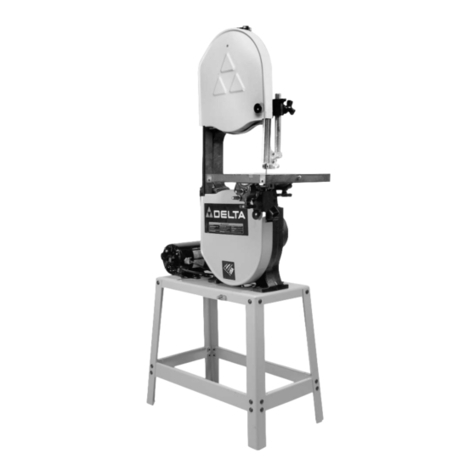
Delta
Delta 28-278 User manual
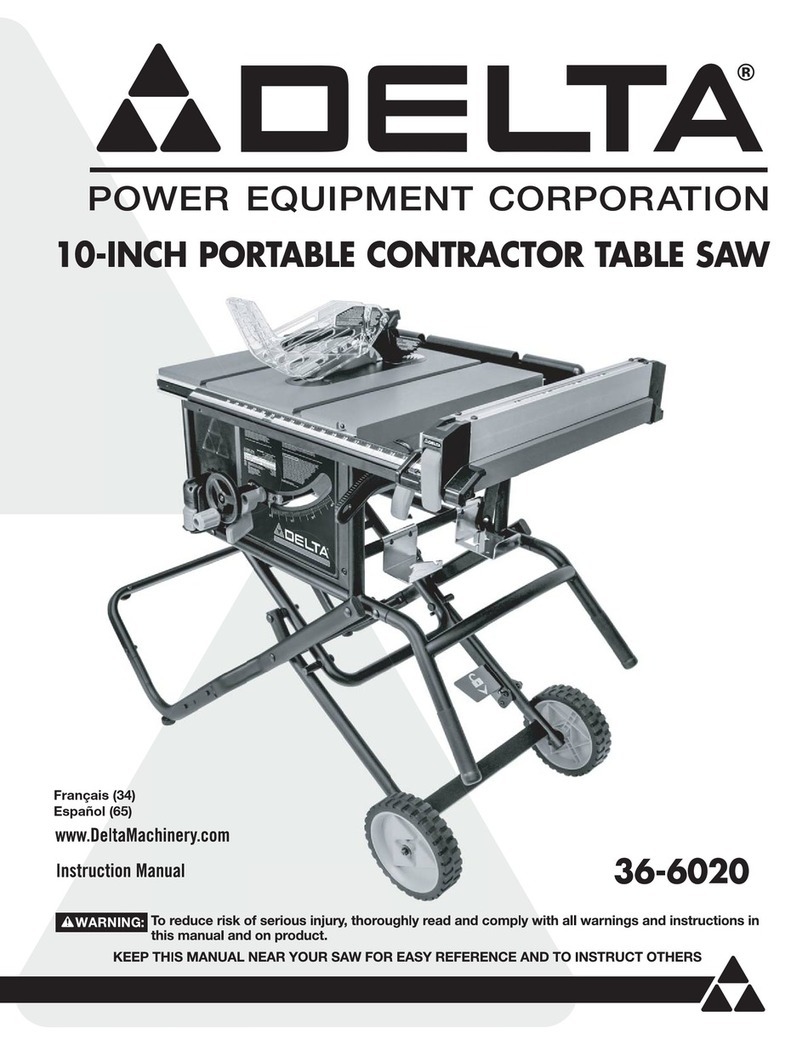
Delta
Delta 36-6020 User manual
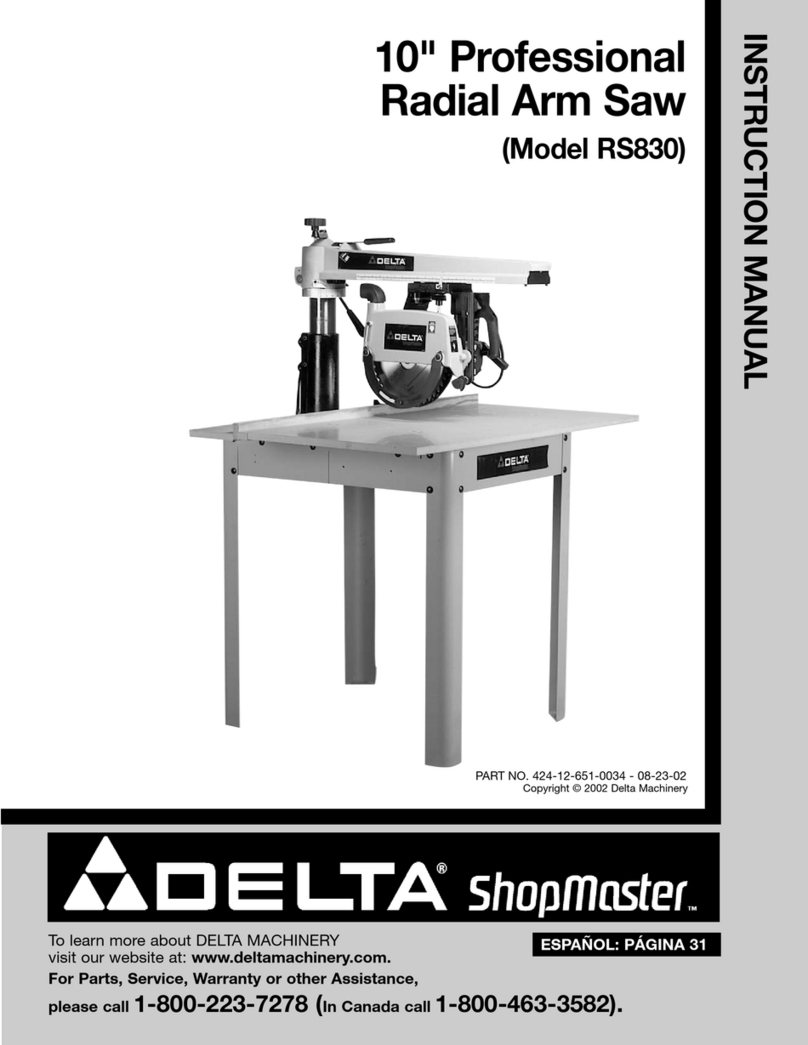
Delta
Delta RS830 User manual

Delta
Delta 36-465 User manual
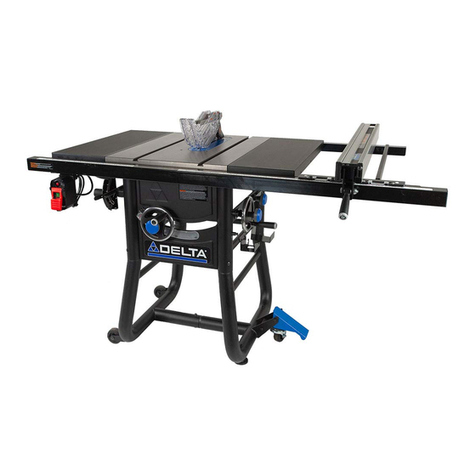
Delta
Delta 36-5000 T2 Series User manual
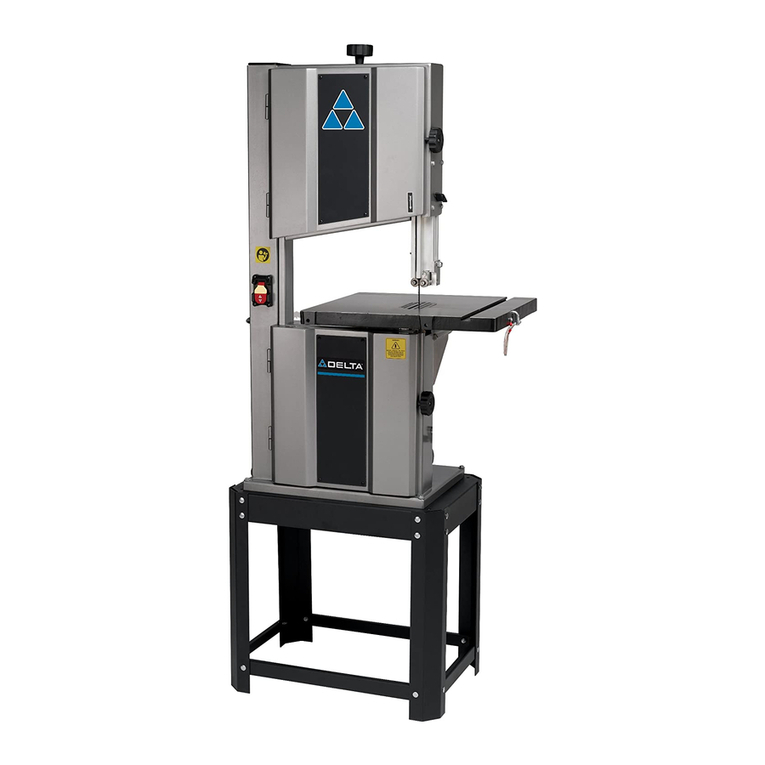
Delta
Delta 28-400 User manual
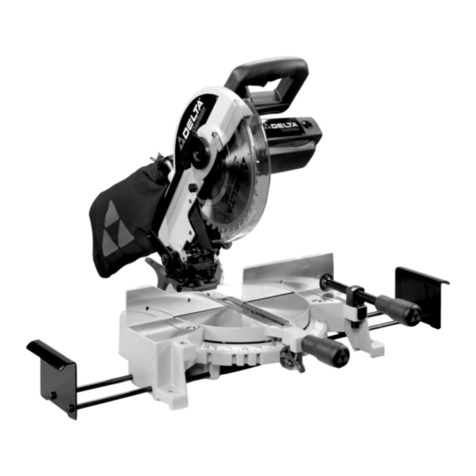
Delta
Delta ShopMaster MS275 User manual
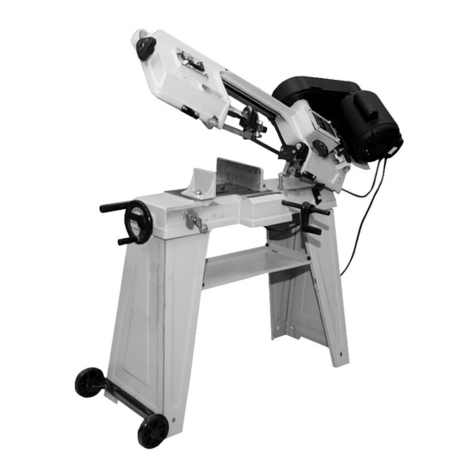
Delta
Delta 20-330 User manual

Delta
Delta WOOD CUTTING BAND SAW 28-275C User manual
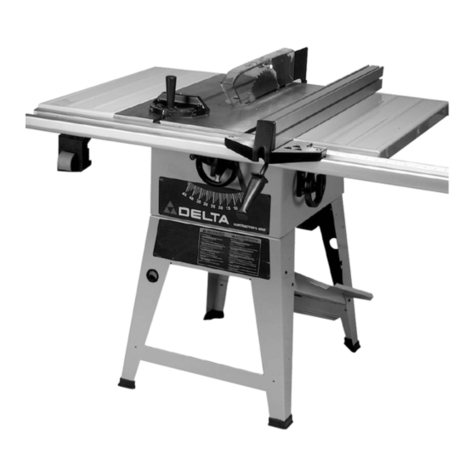
Delta
Delta 36-441B User manual
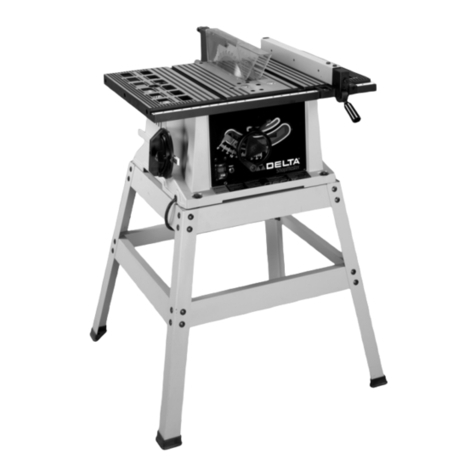
Delta
Delta ShopMaster TS200 User manual

Delta
Delta ShopMaster S26-272L User manual
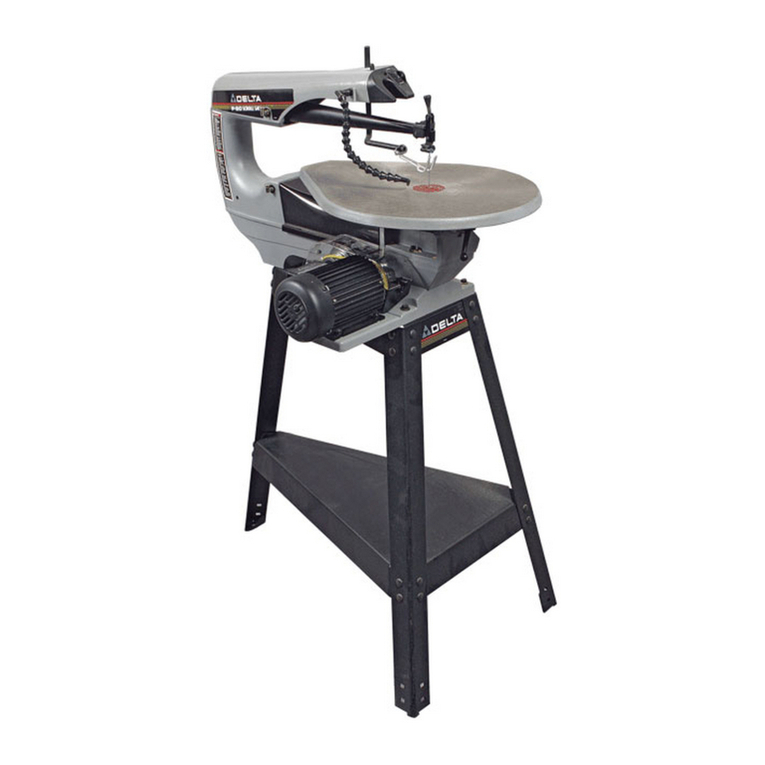
Delta
Delta 40-680 User manual
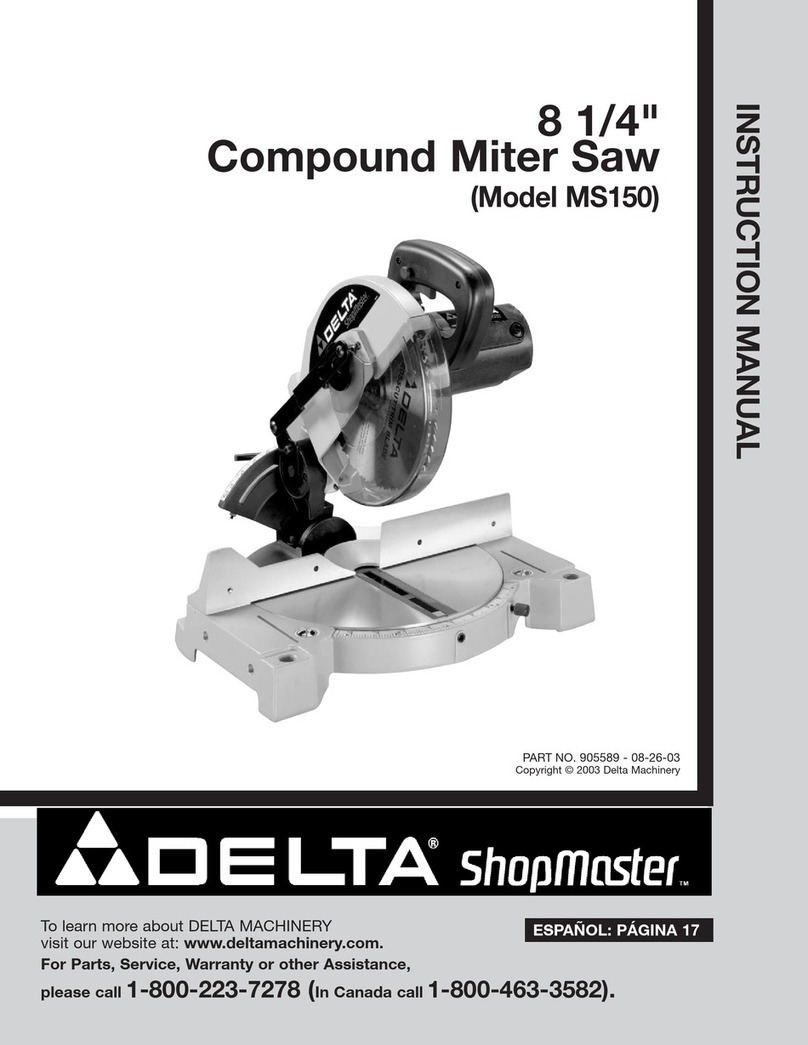
Delta
Delta ShopMaster MS150 User manual

Delta
Delta 28-150 User manual
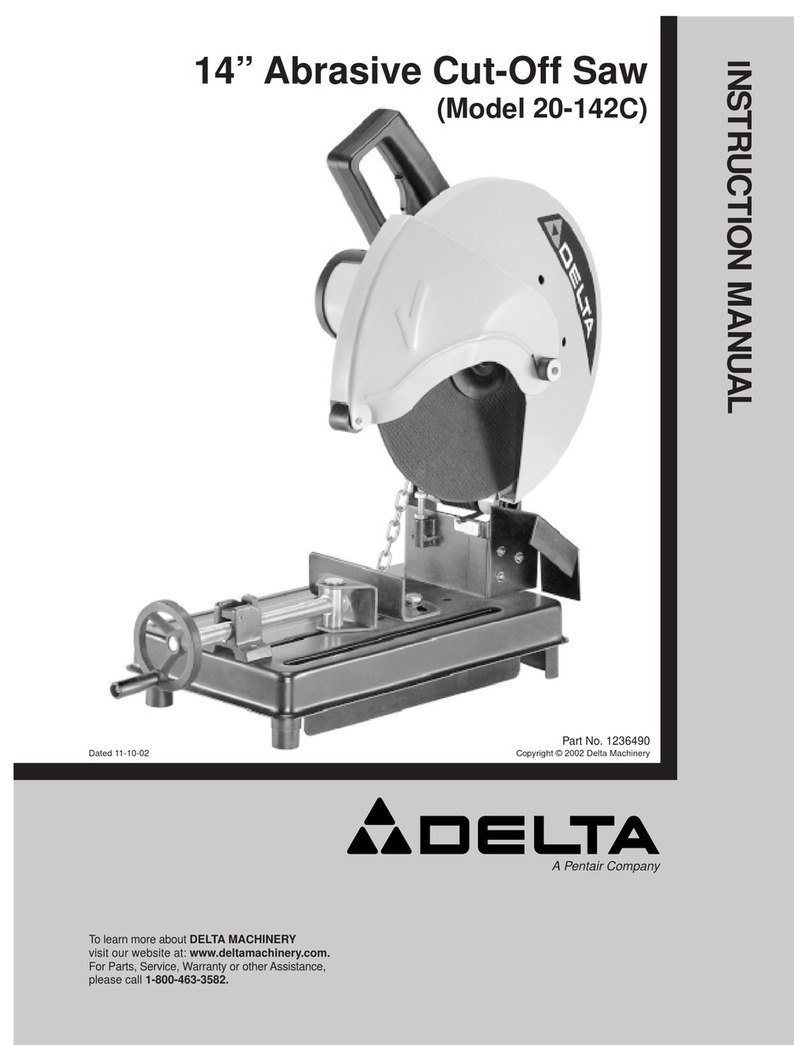
Delta
Delta 20-142C User manual
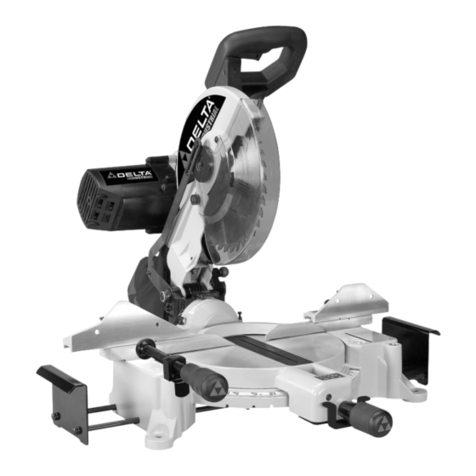
Delta
Delta 36-585 User manual

Delta
Delta 36-220 User manual
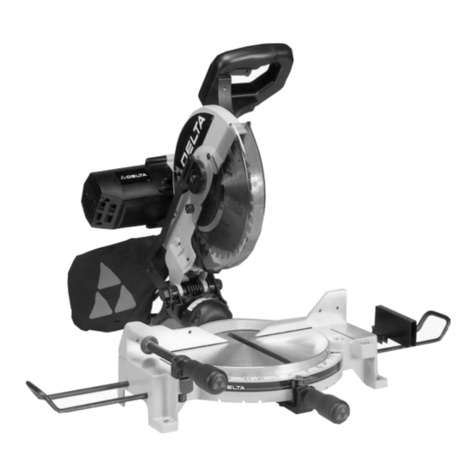
Delta
Delta 36-085 User manual
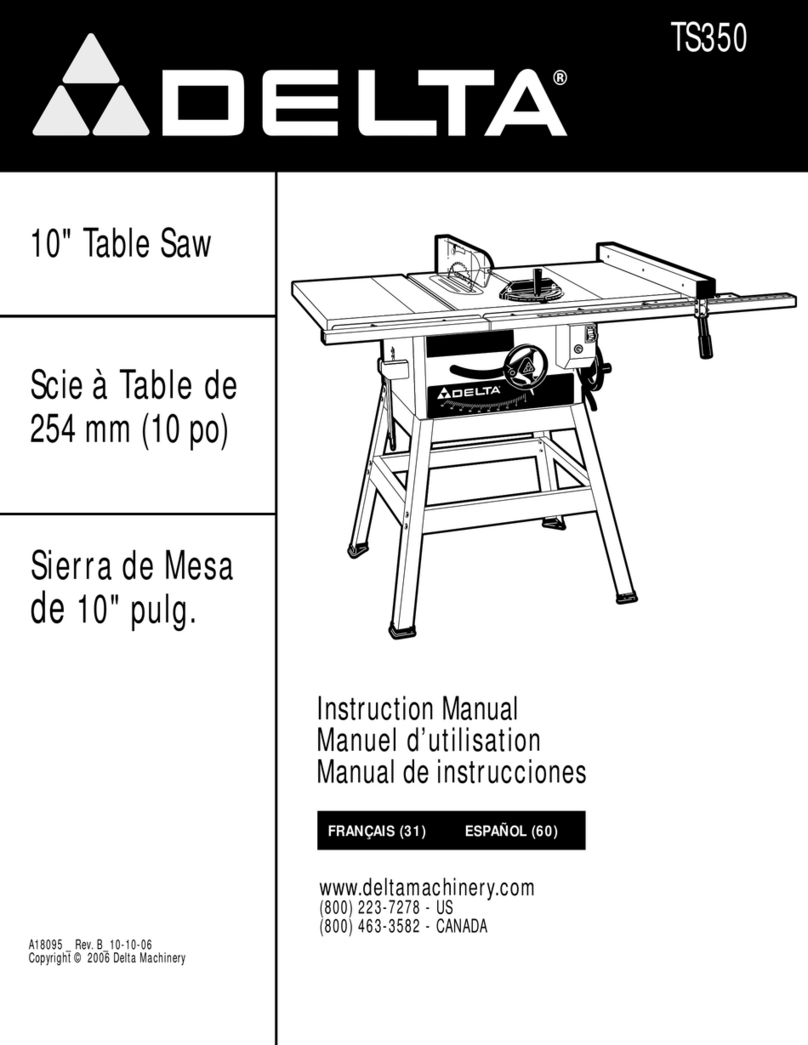
Delta
Delta TS350 User manual
